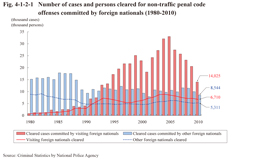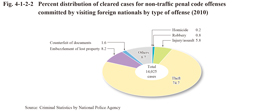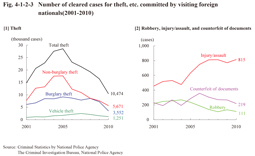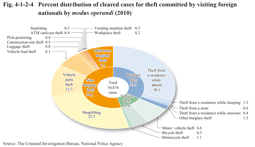Section 2 Trends in Offenses
1 Penal code offenses
Fig. 4-1-2-1 shows the number of cases and persons cleared for non-traffic penal code offenses committed by visiting and other foreign nationals (from 1980). The number of cleared cases of non-traffic penal code offenses committed by visiting foreign nationals started to exceed the number committed by other foreign nationals from 1993. In recent years, the number started to sharply increase from 2002, reaching a record high level in 2005, but then started to decrease, and was 14,025 in 2010 (down 31.8% from the previous year). The number of visiting foreign nationals cleared for non-traffic penal code offenses reached a record high level in 2004, but then started to decrease, and was 6,710 in 2010 (down 6.7% (id.)). In accordance with the increase/decrease in the number of cleared cases committed by visiting foreign nationals the number of cleared cases for non-traffic penal code offenses committed by foreign nationals, including other foreign nationals, reached a record high level of 43,622 in 2005, but then started to decrease from 2006, and was 22,569 in 2010 (down 26.2% from the previous year). The number of foreign nationals cleared increased from 1999, reaching a record high level of 14,786 in 2005, but then started to decrease from 2006, and was 12,021 in 2010 (down 2.8% (id.)) (See Appendix 4-1).
Foreign nationals accounted for 3.7% of the total number (322,620) of persons cleared for non-traffic penal code offenses in 2010.
Fig. 4-1-2-1 Number of cases and persons cleared for non-traffic penal code offenses committed by foreign nationals (1980-2010)
Fig. 4-1-2-2 shows the percent distribution of cleared cases for non-traffic penal code offenses committed by visiting foreign nationals by type of offense in 2010. Theft accounted for the majority of cases at 74.7% (the significant difference between the number of cleared cases and the number of visiting foreign nationals cleared was considered to be due to the fact that many of them were cleared in multiple cases).
Fig. 4-1-2-2 Percent distribution of cleared cases for non-traffic penal code offenses committed by visiting foreign nationals by type of offense (2010)
Fig. 4-1-2-3 shows the number of cleared cases for theft, robbery, and injury/assault, etc. committed by visiting foreign nationals over the last 10 years. The number of cleared cases for theft reached a record high level in 2005, but then started to decrease from 2006, and was 10,474 in 2010 (down 36.3% from the previous year). The number of cleared cases for injury/assault was increasing significantly over recent years, with the number in 2010 being approximately 1.8 times larger than that of 2001.
Fig. 4-1-2-3 Number of cleared cases for theft, etc. committed by visiting foreign nationals(2001-2010)
Fig. 4-1-2-4 shows the percent distribution of cleared cases for theft committed by visiting foreign nationals by modus operandi in 2010. Theft from a residence while absent was the highest in proportion at approximately 30%, followed by shoplifting, vehicle parts theft, motor vehicle theft, and vehicle load theft (See Fig. 1-1-2-2 for the percent distribution of all reported cases for theft by modus operandi).
Fig. 4-1-2-4 Percent distribution of cleared cases for theft committed by visiting foreign nationals by modus operandi (2010)



